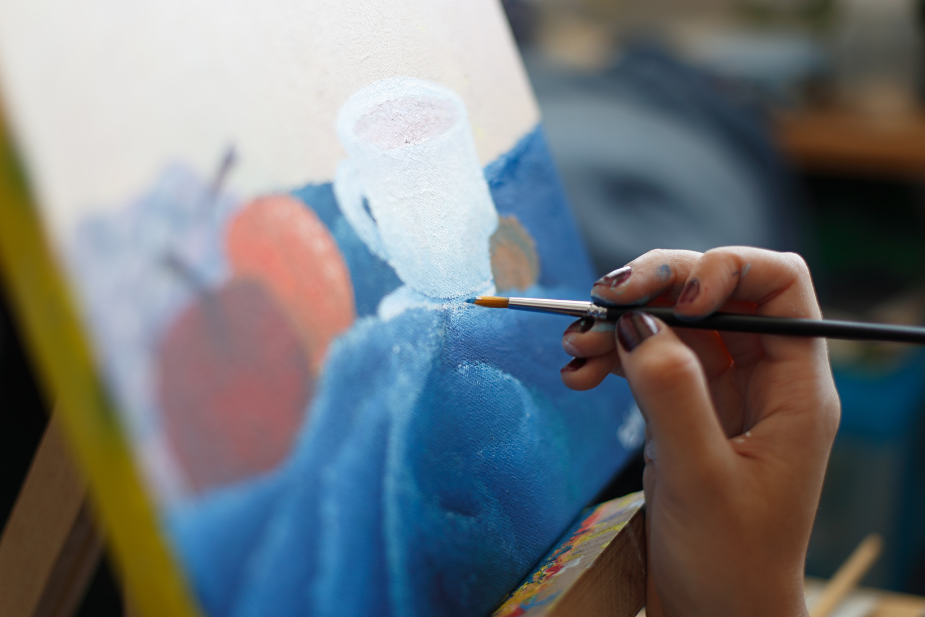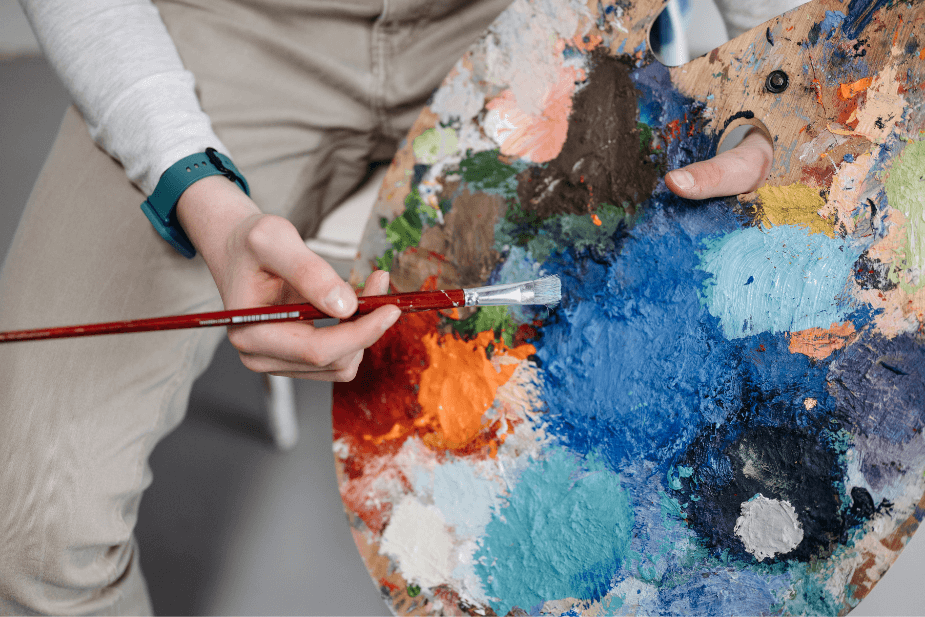Article: Acrylic Painting

Acrylic Painting
Acrylic paint is a fast-drying medium that basically consists of colour pigments, an acrylic binder and a range of different additives - although the latter is not always the case. This may sound like a simplification, but this is because acrylic paints are produced in many grades, by many manufacturers and the various products do not always declare what all the additives in their products are.
At Stelling, we naturally make sure that we only have quality products, selected precisely for the quality and quantity of pigments, that the binder works as it should - ideally this should be flexible, transparent and possess great strength - and products with few or no additives.
Most types of acrylic paint are water-based, but despite this, acrylic paints are water-resistant after drying and some acrylics achieve this property after as little as 15-20 minutes drying time. This leads to a working process where speed, flexibility, intuition and creativity are paramount.
Another unique characteristic of acrylic paint is that depending on how much the consistency is altered through dilution with water, or completely changed through the use of media and/or gels, the more the acrylic paint achieves the specific properties of watercolour, gouache or oil paint respectively.
At Stelling we therefore like to say that acrylic paint is a bit of a chameleon, but conversely acrylic paint can also achieve unique properties through the use of gels and media that are not available in any other product.
The combination of enormous flexibility, fast drying time and a safe and easy profile makes this product one of our top sellers and we recommend anyone with a creative genius - experienced as well as beginners - to try their hand at this type of paint.
The story behind
The history of acrylic paints starts in Germany in the early 20th century, where Otto Röhm and business partner Otto Haas invented and patented a host of important products. Chief among these in this regard was the development of acrylic resin and later the first "true" acrylic emulsion, i.e. chemical composition specifically designed for use as paint.
Building on these chemical breakthroughs, acrylic paints based on mineral alcohol were developed in a short time and, after further experimentation and development, water-based acrylic paints became available.
These early acrylic paints, sold as latex paints, were developed for interior and exterior house painting and were intended for industrial use, but soon the artistic possibilities were explored and developed, leading to the sea of products we have access to today.
It is therefore a fairly modern medium - at least when compared to watercolour and oil painting, the latter of which dates back to the Renaissance.
For the same reason, acrylic painting came to be the standard-bearer for the new art movements of the 20th century that reflected modern reality: abstract expressionism, photorealism and pop art emerged or developed in this melting pot and acrylic painting became a preferred medium for many practitioners who quickly learned to appreciate its unique qualities.
Classifications
Artist
"Artist" is each manufacturer's most exclusive and most expensive grade of acrylic paint. The quality is characterized by enormously high reliability - both in terms of stability and durability - as well as how colorfast it is. In addition, the Artist series contains an enormously high amount of colour pigments and some absolutely fantastic binders.
This gives a very impactful effect, which is why you will often "tone down" your Artist acrylic paint by diluting it with water and/or a medium and mixing it with other colours, but you also have the opportunity to create works with an explosion of dynamic and intense colours by using the product directly from the can or tube.
Another advantage of Artist is that you don't have to worry when mixing two or more colours. This helps to distinguish Artist quality from Studio, where certain very expensive pigments are replaced by cheaper ones and so-called "hues" are created. These resemble the desired pigment well enough, but can give altered results when mixing colours.
In the Artist ranges, products will typically be priced according to how expensive the individual colour pigment may be. Therefore, you will often see certain yellows, reds and blues being quite a bit more expensive than earth tones and white and black, for example.
Studio
"Studio", or "student" as it is also sometimes known, is a cheaper class classification than "Artist" and the common wisdom is that these are affordable alternatives can be used during the preparation of studio works and/or in learning situations where a lot of acrylic paint needs to be flung onto a canvas in a hurry and it would be too costly to use Artist.
So, although a cheaper product with fewer pigments and a less good binder, you can easily use these series for your finished works - even as a professional artist. It is just important to be aware that the quality is different from Artist.
As is the case with the "big brother", not all pigments are born equal. You will therefore sometimes find that products in the Studio ranges have a different amount of colour pigment in them, as well as selected colours not being available in Studio quality at all, as the pigments are simply too expensive for a more affordable range. These exotic or rare colour pigments are replaced by cheaper alternatives - so-called hues, which are confusingly similar but in some cases have altered properties due to the changed composition.
Variants
Acrylic paints come in many varieties, so you can always find a product to suit your exact needs. In Stelling's large selection you can find:
- Heavy Body, which as the name suggests has a thicker consistency and is well suited for impasto techniques or other situations where the paint needs to "stand up" on the canvas as well as show individual brush strokes and/or use of a palette knife.
- "Medium Viscosity", known by names such as Soft Body, Fluid and High Flow, which retains the same high pigment count of Heavy Body but comes in a more fluid version. These are particularly suitable for airbrush use.
- Open, a type of acrylic paint developed by GOLDEN that possesses qualities of the oil paint. You will therefore be able to work with the same colour for much longer periods than a traditional acrylic paint.
- Iridescent, pearl and interference series have their pigments mixed with mica or even bronze powder, creating unique and very beautiful effects where the colour can reflect light, shine like newly minted coins or change completely; depending on whether it is painted over white or black.
Special properties
Acrylic paint's greatest strength and best feature is its flexibility. We've already described how it can be thinned, added to media or gels to "mimic" other media, used to paint over anything - even outdoors - or even mixed freely with other media, but that's not all.
Acrylic paint, with its water resistance, is well suited as an undercoat in a multi-media project - what is popularly called mixed media. While we're on the subject, it's also worth mentioning that you can easily mix sand, rice or other materials into your acrylic paint. This textured paint is used to create lifelike environments in the figure and model hobby, among other things.
Technically, you also have a wealth of options. From the very advanced and technically demanding to the more intuitive and beginner-friendly such as drybrushing (dry brush on a dry canvas), finger painting that is exactly what you think it is or "pouring", where special acrylic paints such as GOLDENS Fluid line or paints added with Pouring Medium are poured over your project from a container, creating fascinating, unique and organic effects.
And again, all of these techniques and mediums can of course be combined in your project. The only limit is your imagination.
Why choose acrylic paint over oil paint
The immediate advantage is the short drying time. It allows for greater productivity on each project, as there is no unnecessary waiting while the paint needs time to dry. Conversely, the short drying time also means that you cannot work as easily with, for example, a wet-on-wet technique.
If you are thinking of switching from oil paints or just want to be able to work longer with the same colour, you have the option of extending the drying time by using a retarder or by choosing a product from an Open series, such as this one from Golden.
Another strength of acrylic paint is that it lasts longer and doesn't yellow. In addition, acrylic paints possess a much higher natural elasticity, which in practice means that you don't have to worry about crazing or how "bold" or "lean" a given colour is. Read more about "fat-over-lean" in our section on oil paints here.
If you're painting with oil, it's necessary to cover the painted surface with a primer so that the oil paint doesn't seep through and rot it. With acrylic paint, this isn't necessary unless you're working on wood or other materials that soak up a lot of liquid or are hugely porous. However, as a general rule, at Stelling we always recommend that you use a primer - especially if you're painting on surfaces other than a traditional canvas. For example, check out these delicious gessoes from GOLDEN and Vallejo, which are particularly suitable for this purpose.
Finally, it's worth mentioning that you can go a long way by using water to dilute the paint. This also applies to the subsequent cleaning of brushes and work area, which is done in a jiffy with warm water and a little soap. Once the acrylic paint has dried completely - on your palette, for example - it can be easily and effortlessly scraped off with a knife.
That's why we recommend acrylic paint over oil paint for those who are climate conscious, suffer from allergies, work at home or just want to be able to sit at the kitchen table and work without having to worry about the use of solvents or other toxic chemicals.
Why choose acrylic paint over watercolour
When it comes to the difference between acrylic paint and watercolor, attention will quickly turn to opacity versus transparency as well as the reactivity of watercolor versus the water resistance of acrylic.
In terms of the first difference, we've already described how acrylic paint can be made incredibly fluid and used to create watercolour-like effects, but in its "straight-out-of-the-well" state, the average acrylic paint will have far higher opacity and far less transparency than a given watercolour. In practice, this means that you can build your project "layer-on-layer" using acrylic paints with particularly high opacity without having to worry about the visibility of underlying layers of paint. This property is enhanced by several thin layers of paint on top of each other.
The latter difference is more a matter of particular qualities of each medium than an actual advantage in choosing one over the other.
If you work with watercolours, you probably already know that a work can be reactivated with water and that you can even use this property as an eraser. This is certainly not the case for acrylic paints, which conversely can be painted over again and again without you having to worry about underlying layers of paint suddenly "coming alive", soaking or blending.
A really clever solution to this issue is, of course, to use both media - a technique called mixed media and, as described above, another of acrylic paint's many strengths.
If you need help or guidance with your next acrylic painting project, drop us a line - we're here to help.


